To Determine the Color of a Tonkinese Cat
Most people get confused by the Tonkinese coat colors when they first see a Tonkinese cat.Tonkinese come in 4 base coat colors (platinum, champagne, natural, and blue) with 3 coat patterns (point, mink, solid) for a total of 12 individual color combinations. By base colors, we mean the color of the points (extremities: face, ears, tail, and legs), not the body color. By coat pattern, we mean the contrast between the color of the points and the body color.
See the Tonkinese Genetics page for a very technical explanation of what creates the coloring of the coat patterns and the color range of eye color from blue to aqua to yellow/green.
Summary of How to Determine Tonkinese Colors
Step 1: Determine the Base Color. Look at the points (extremities: face, ears, tail, and legs) and ignore the body. Select the base color of platinum, champagne, natural, or blue.
Step 2: Determine the Coat Pattern. Look at the body color and contrast it to the points. Select the pattern based on the degree of contrast: point, mink, or solid.
The combination of base color name and coat pattern name give you the total color name. For example: Champagne Point, Natural Solid, Blue Mink, or Platinum Mink.
Details for Determining Color
Step 1: Determine the Base ColorTo determine the color of a Tonkinese first look at the points and ignore the body. Select the base color: |
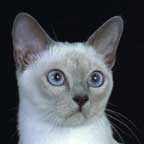 Platinum: face is frosty gray |
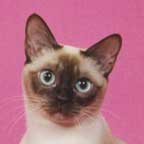 Champagne: face is medium brown |
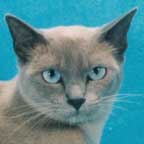 Blue: face is slate blue |
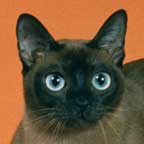 Natural: face is dark brown |
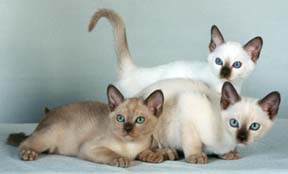
Step 2: Determine the Coat Pattern
Look at the degree of contrast between the points and the body color. The pattern names of point, mink, and solid are misleading. All Tonkinese are pointed cats and none are truly solid. Visualize them as varying degrees of contrast, ranging from a strong contrast to a low contrast which can appear almost solid.In this example, all three kittens are the same base color (champagne), but each is a different coat pattern. Note that the points are the same color in all the kittens; it's the point to body contrast that varies.
Champagne Solid (left): low contrast, body color may be a slightly lighter shade of the point color, with very little contrast between body and point color. Eyes (as an adult) are green to yellow/green.
Champagne Mink (lower right): medium contrast, body color should be a rich, even, unmarked color, shading almost imperceptibly to a slightly lighter hue on the underparts. There must be a distinct contrast between body and point color. Eyes (as an adult) are aqua.
Champagne Point (top): high contrast, body color should be off-white, any shading relative to the point color; overall body color should be in marked contrast to the point color. Eyes (as an adult) are blue.
How to check body color: To compare the contrast of tail to body color, wrap the tail along the side of the body furthest away from you and view the colors side by side.
Point to body contrast varies within each base color group. Champagnes have the highest degree of contrast of the four base colors and were used to illustrate the pattern and age differences in the examples above. Blues have the least, with Platinums and Naturals falling in between. A Champagne Solid may have the same amount of contrast as a Blue Mink. A Blue Solid may appear solid, but a Champagne Solid illustrates that they are not truly solid. Points all have light bodies, but the body color varies; the Naturals have the darkest tone and the Platinums have the lightest. All of the colors darken with age.
Eye Color
Eye color does not determine coat pattern. Body color, contrast and shading to the points do determine coat pattern. The CFA Standard defines the appropriate eye color for each coat pattern and not every cat will have the specified eye color for its pattern. A Natural with a fawn-to-cream body with aqua eyes is a Natural Point with eye color not to CFA Standard, not a Natural Mink with a super light body.
How to check Eye Color: Cradling the cat and looking at the iris from above may help you to see the color more accurately. Looking at the eyes in natural light is helpful, but not a foolproof test; the color of the light varies based on atmospheric conditions.
Color Changes with Age
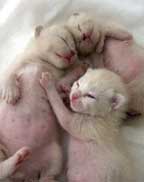 All Tonkinese cats are born with blue eyes and uniform color through out their body, ranging from off-white to darker colors.
The kittens on the right have just started to get a tiny bit of color on their paws and noses. Their distinctive coat patterns and eye color develop over time.
All Tonkinese cats are born with blue eyes and uniform color through out their body, ranging from off-white to darker colors.
The kittens on the right have just started to get a tiny bit of color on their paws and noses. Their distinctive coat patterns and eye color develop over time.
 |
 |
 |
 |
The example on the right illustrates different Champagne Mink Tonkinese ranging from age 5 weeks to a mature adult. The contrast between their points and body is caused by enzyme and pigment interactions affected by body temperature. The warmer areas of their body are lighter and the cooler areas of their body are darker. As they mature, their color usually gets darker, with some exceptions. Note how the size of the "mask" on the face "grows" as well as getting darker. These are four different cats.
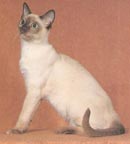 |
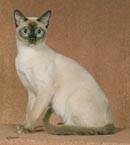 |
 This example is GC, GP, BW, RW Sonham Chat-O Nerf Brut, DM showing him age from 6 months to 8 years. He lightened at 8 years when he was neutered. Images Copyright © Chanan All Rights Reserved |
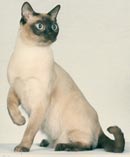 |
All 12 Color/Coat Pattern Examples With CFA Tonkinese Standard Definitions
Each color will expand into a new page with several examples of each specific color/coat pattern with large photos. Click on the photo or color name.
Warning: Colors are not accurate on monitors. Do not use these photos to make color determinations, but use the text description.
Base Colors |
Coat Patterns |
||
Point Body color: should be off-white, any shading relative to the point color; overall body color should be in marked contrast to the points. Eye color: blue. |
Mink Body color: should be a rich, even, unmarked color, shading almost imperceptibly to a slightly lighter hue on the underparts. Eye color: aqua. |
Solid Body color: may be a slightly lighter shade of the point color, with very little contrast with points. There will be more contrast between points and body color for the Champagne and Platinum than for the Natural and Blue. Eye color: green to yellow/green. |
|
Blue Points: slate blue. |
Blue Point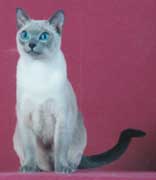 Body: off-white with warm gray shading. |
Blue Mink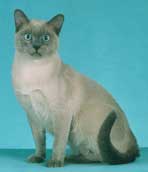 Body: soft, blue-gray with warm overtones. |
Blue Solid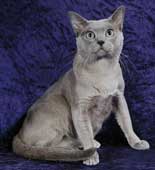 Body: slate blue with warm overtones. |
Champagne Points: medium brown |
Champagne Point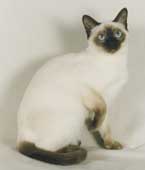 Body: ivory with buff-tan shading. |
Champagne Mink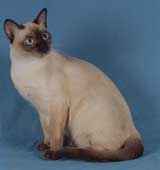 Body: buff-cream to beige. Reddish highlights acceptable. |
Champagne Solid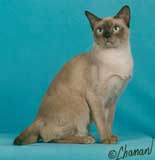 Body: golden tan to light coffee brown. |
NaturalPoints: dark brown. |
Natural Point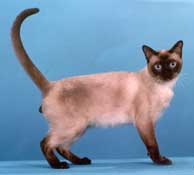 Body: fawn to cream. |
Natural Mink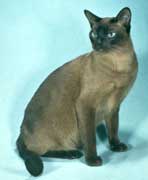 Body: medium brown. Ruddy highlights acceptable. |
Natural Solid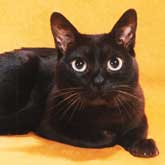 Body: sable brown. |
PlatinumPoints: frosty gray. Nose leather: lavender-pink to lavender-gray Paw pads: lavender- pink. |
Platinum Point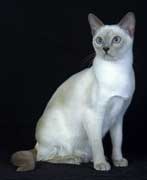 Body: pearly white. |
Platinum Mink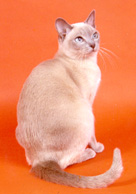 Body: pale, silvery gray with warm overtones. Not white or cream. |
Platinum Solid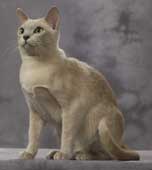 Body: dove gray. |

